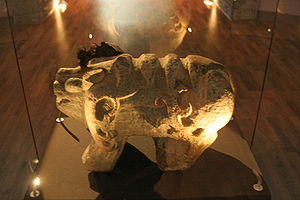
Seoksu
Encyclopedia

Gongju National Museum
Gongju National Museum is a national museum in Gongju, South Korea. The Gongju National Museum holds 10,000 artifacts including 19 national treasures and 3 treasures excavated in Daejeon and Chungcheongnam-do areas, especially artifacts from Tomb of King Muryeong.-See also:*List of museums in...
. This kind of protective stone animal originated from the funerary customs of the Eastern Han Dynasty. http://www.cha.go.kr/english/search_plaza/ECulresult_Db_View.jsp?VdkVgwKey=11,01620000,34.
Seoksu were used in a variety of different ways to protect their owner. They could be placed in front of the tomb or palace - they were supposed to guard. http://www.cha.go.kr/english/search_plaza/ECulresult_Db_View.jsp?VdkVgwKey=11,01620000,34. They could also be placed inside the tomb itself. http://www.cha.go.kr/english/search_plaza/ECulresult_Db_View.jsp?VdkVgwKey=11,01620000,34. Seoksu could also be placed in the pile of the stone and rubble used to surround the tomb and can be found carved on the bases of pagodas. http://www.cha.go.kr/english/search_plaza/ECulresult_Db_View.jsp?VdkVgwKey=11,01620000,34.
This particular figure was found in the center aisle of King Muryeong's Tomb. It is 30.8 centimeres in height, 48 centimeters in length, and 22 centimeters in width. http://www.cha.go.kr/english/search_plaza/ECulresult_Db_View.jsp?VdkVgwKey=11,01620000,34. The animal is somewhat realistic, depicting a tail and anus. http://www.cha.go.kr/english/search_plaza/ECulresult_Db_View.jsp?VdkVgwKey=11,01620000,34. However, a steel horn shaped like a leaf and flame patterns depicting wings which run from the left and right of the body and on the legs shows that it is not based on a real creature. http://www.cha.go.kr/english/search_plaza/ECulresult_Db_View.jsp?VdkVgwKey=11,01620000,34. The Seoksu has a blunt mouth and a big, nostril-less nose. http://www.cha.go.kr/english/search_plaza/ECulresult_Db_View.jsp?VdkVgwKey=11,01620000,34. The mouth has remnants of red paint on it, suggesting that the figure was once brightly painted. http://www.cha.go.kr/english/search_plaza/ECulresult_Db_View.jsp?VdkVgwKey=11,01620000,34.
Although the Seoksu is of a lower quality than some of the other treasures found within the tomb, it is especially valuable because it is the first stone figure excavated buried with Baekje kings.
See also
- Tomb of King MuryeongTomb of King MuryeongThe Tomb of King Muryeong, also known as Songsan-ri Tomb No. 7, is the ancient tumulus of King Muryeong, who ruled the Baekje Kingdom from 501 to 523, and his queen...
- National treasures of Korea
- National treasures of North KoreaNational treasures of North KoreaDesignated national treasures of North Korea are tangible artifacts, sites, and buildings deemed to have significant historical or artistic value.-No. 1-50:-No. 51-100:-No. 101-150:-No...
- List of Korea-related topics

